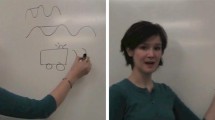Abstract
The effects of systematically varied interactivity on learning from interactive video were studied. A total of 98 high-school students served as subjects. Four increasingly interactive versions of instruction were used. After receiving the instruction, students took a 23-item recall test. Recall was significantly affected by the amount and type of interactivity provided. The fully interactive version yielded the greatest recall but took longer to complete than any of the other presentations. Time to complete the instruction was shortest, and the resulting rate of learning was greatest, for the simple linear video presentation.
Similar content being viewed by others
References
Anderson, D. R., & Lorch, E. P. (1983). Looking at television: Action or reaction? In J. Bryant and D. R. Anderson (Eds.),Children's understanding of television. New York: Academic Press.
Bandura, A. (1977).Social learning theory. Englewood Cliffs, NJ: Prentice-Hall.
Calvert, S. L., Huston, A. C., Watkins, B. A., & Wright, J. C. (1982). The effects of selective attention to television forms on children's comprehension of content.Child Development, 53, 601–610.
Clark, R. E. (1983). Reconsidering research on learning from media.Review of Educational Research, 53, 445–460.
DeBloois, M.L. (1982). Principles for designing interactive videodisc instructional materials. In M. L. DeBloois (Ed.),Videodisc/microcomputer courseware design. Englewood Cliffs, NJ: Educational Technology Publications.
Edwards, J., Norton, S., Taylor, S., Webb, M., & Dusseldorp, R. (1975). How effective is CAI?Educational Leadership, 33, 147–153.
Floyd, S. (1982). Thinking interactively. In S. Floyd & B. Floyd (Eds.),Handbook of interactive video. White Plains, NY: Knowledge Industry Publications.
Garhart, C., & Hannafin, M. J. (1985, March).Interactive video as an instructional medium: A look at related research. Presented at the annual meeting of the Association for the Development of Computer-Based Instructional Systems, Philadelphia.
Gilman, D. A. (1969). Comparison of several feedback methods for correcting errors by computer-assisted instruction.Journal of Educational Psychology, 60, 503–508.
Guttentag, R. E. (1984). The mental effort requirement of cumulative rehearsal: A developmental study.Journal of Experimental Child Psychology, 37, 92–106.
Hannafin, M. J. (1985). Empirical issues in the study of interactive video.Educational Communication and Technology Journal, 33, 235–247.
Hannafin, M. J., & Garhart, C. (1985, March)Research methods for the study of interactive video. Presented at the annual meeting of the Association for the Development of Computer-Based Instructional Systems, Philadelphia.
Hannafin, M J., Garhart, C., Rieber, L. P., & Phillips, T. L. (1985). Keeping interactive video in perspective: Tentative guidelines and cautions in the design of interactive video. In E. Miller (Ed.),Educational Media and Technology Yearbook. Denver, CO: Libraries Unlimited.
Kulik, J. A., Bangert, R. L., & Williams, G. W. (1983). Effects of computer-based teaching on secondary school students.Journal of Educational Psychology, 75, 19–26.
Kulik, J. A., Kulik, C.-L. C., & Cohen, P. A. (1980). Effectiveness of computer-based college teaching.Review of Educational Research, 50, 525–544.
Lesser, H. (1977).Television and the preschool child. New York: Academic Press.
Lorch, E. P., Anderson, D. R., & Levin, S. R. (1979). The relationship of visual attention to children's comprehension of television.Child Development, 50, 722–727.
Pawley, R. (1983). It's becoming an interactive world.Educational and Industrial Television, 15(6), 80–81.
Salomon, G. (1981). Introducing AIME: The assessment of children's mental involvement with television. In H. Gardner & H. Kelly (Eds.),Children and the worlds of television. San Francisco: Jossey-Bass.
Salomon, G. (1983). Television watching and mental effort: A social psychological view. In J. Bryant & D. Anderson (Eds.),Children's understanding of television. New York: Academic Press.
Tennyson, R. D. (1981). Use of adaptive information for advisement in learning concepts and rules using computer-assisted instruction.American Educational Research Journal, 18, 425–438.
Wooley, R. D. (1982). Training applications: Making interactive video technology work effectively. In M. L. DeBloois (Eds.),Videodisc/microcomputer courseware design. Englewood Cliffs, NJ: Educational Technology Publications.
Author information
Authors and Affiliations
Additional information
An erratum to this article is available at http://dx.doi.org/10.1007/BF02768426.
Rights and permissions
About this article
Cite this article
Schaffer, L.C., Hannafin, M.J. The effects of progressive interactivity on learning from interactive video. ECTJ 34, 89–96 (1986). https://doi.org/10.1007/BF02802581
Issue Date:
DOI: https://doi.org/10.1007/BF02802581




